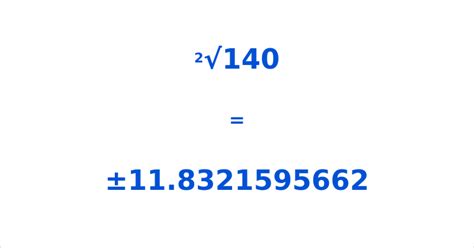What Is The Square Root Of 140
listenit
Apr 05, 2025 · 4 min read

Table of Contents
What is the Square Root of 140? A Deep Dive into Approximation and Calculation
The seemingly simple question, "What is the square root of 140?" opens a door to a fascinating exploration of mathematical concepts, approximation techniques, and the power of computational tools. While a precise answer isn't readily expressible as a simple fraction or decimal, understanding how to approach this problem reveals much about the nature of numbers and mathematical problem-solving.
Understanding Square Roots
Before diving into the specifics of the square root of 140, let's establish a foundational understanding of what a square root represents. The square root of a number is a value that, when multiplied by itself (squared), equals the original number. For example, the square root of 9 is 3 because 3 * 3 = 9. This concept is fundamental to many areas of mathematics, science, and engineering.
The square root of 140, denoted as √140, doesn't yield a whole number. Numbers like 140, whose square roots are not whole numbers, are often referred to as non-perfect squares. This means we'll need to explore methods of approximation and calculation to find its value.
Methods for Approximating √140
Several techniques can be used to approximate the square root of 140. Let's explore some of the most common and effective approaches:
1. Estimation through Perfect Squares
One of the simplest methods involves identifying perfect squares close to 140. We know that 11² = 121 and 12² = 144. Since 140 lies between these two perfect squares, we can deduce that √140 is between 11 and 12. This gives us a rough estimate, but it's not precise enough for many applications.
2. Babylonian Method (or Heron's Method)
This iterative method provides a more accurate approximation. It's based on repeatedly refining an initial guess until the desired level of accuracy is achieved. The formula is:
x<sub>n+1</sub> = ½ (x<sub>n</sub> + S/x<sub>n</sub>)
Where:
- x<sub>n</sub> is the current approximation
- x<sub>n+1</sub> is the next (improved) approximation
- S is the number whose square root is being calculated (in this case, 140)
Let's demonstrate this with an initial guess of 11.5:
- Iteration 1: x<sub>1</sub> = ½ (11.5 + 140/11.5) ≈ 11.8326
- Iteration 2: x<sub>2</sub> = ½ (11.8326 + 140/11.8326) ≈ 11.8322
Notice how quickly the approximation converges. After just two iterations, we have a highly accurate approximation of √140.
3. Using a Calculator or Computer
The most straightforward method is to utilize a calculator or computer software. These tools employ sophisticated algorithms to calculate square roots to a high degree of precision. Most scientific calculators and computer programming languages (like Python, Java, etc.) have built-in functions for this purpose. The result will typically be displayed as a decimal approximation.
The Decimal Approximation of √140
Using a calculator or computational software, we find that the square root of 140 is approximately 11.832159566199232. This decimal representation is an approximation, as the actual value is irrational – it cannot be expressed as a simple fraction and continues infinitely without repeating.
Exploring the Irrational Nature of √140
The fact that √140 is irrational is an important aspect to understand. Irrational numbers are numbers that cannot be expressed as a fraction of two integers. Their decimal representations are non-terminating and non-repeating. This means the decimal approximation above is just a truncation of an infinitely long decimal.
Applications of Square Roots
Understanding and calculating square roots is crucial in many fields, including:
- Geometry: Calculating distances, areas, and volumes often involves square roots (e.g., Pythagorean theorem).
- Physics: Solving equations of motion, calculating energy, and analyzing wave phenomena frequently utilize square roots.
- Engineering: Design calculations, structural analysis, and signal processing often rely on square root computations.
- Finance: Compound interest calculations and risk assessment models employ square roots.
- Statistics: Standard deviation and variance calculations are heavily reliant on square roots.
Beyond the Calculation: Mathematical Exploration
While finding the numerical value of √140 is important, this problem provides a springboard for exploring deeper mathematical concepts. For example, we can analyze the prime factorization of 140 (2² * 5 * 7) to gain insights into its square root. This factorization helps us understand why the square root is irrational – the prime factors don't appear in pairs.
Furthermore, understanding the approximation methods discussed earlier allows us to appreciate the iterative nature of many mathematical algorithms. The Babylonian method, for instance, showcases the power of successive refinement to achieve increasingly accurate results.
Conclusion: More than Just a Number
The seemingly straightforward question of "What is the square root of 140?" unfolds into a rich exploration of mathematical concepts, computational techniques, and the practical applications of square roots across diverse fields. While the decimal approximation provides a practical answer, understanding the underlying principles and methods for approximation enhances our appreciation of the beauty and complexity of mathematics. The journey to finding √140 is as valuable as the answer itself, highlighting the importance of both precise calculation and conceptual understanding.
Latest Posts
Latest Posts
-
21 Is 42 Of What Number
Apr 06, 2025
-
Initial Value And Rate Of Change
Apr 06, 2025
-
500 Ml Equals How Many Oz
Apr 06, 2025
-
I Have But One Life To Give
Apr 06, 2025
-
Is Square Root Of 4 A Rational Number
Apr 06, 2025
Related Post
Thank you for visiting our website which covers about What Is The Square Root Of 140 . We hope the information provided has been useful to you. Feel free to contact us if you have any questions or need further assistance. See you next time and don't miss to bookmark.
